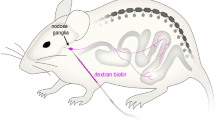Abstract.
The function of presynaptic α2-autoreceptors was studied in the hippocampus, occipito-parietal cortex, atria and vas deferens of NMRI mice, mice in which the α2A/D-, the α2B- or α2C-adrenoceptor gene had been disrupted (α2A/DKO, α2BKO and α2CKO, respectively), and the wildtype mice from which the knockout animals had been generated. Tissue pieces were preincubated with 3H-noradrenaline and then superfused and stimulated electrically.
The α2-adrenoceptor agonist medetomidine reduced the electrically evoked overflow of tritium in all tissues from all mouse strains (stimulation with single pulses or single high-frequency pulse trains, called POPs, i.e. pulse patterns leading to minimal autoinhibition). The effects of medetomidine did not differ in NMRI, wildtype, α2BKO and α2CKO mice but were greatly reduced in α2A/DKO brain preparations and to a lesser extent in α2A/DKO atria and vasa deferentia. Six drugs were tested as antagonists against medetomidine. Their pKd values indicated that the hippocampal and occipito-parietal α2-autoreceptors in NMRI and wildtype mice were α2D (the rodent variant of the α2A/D-adrenoceptor) whereas the atrial and vas deferens α2-autoreceptors in NMRI and wildtype mice could not be identified with a single α2 subtype. Deletion of the α2A/D gene changed the pKd values in all tissues so that they now reflected α2C properties, whereas deletion of the α2C gene changed the pKd values in atria and vasa deferentia so that they now had α2D properties (as they had in NMRI and wildtype brain preparations). Autoinhibition by released noradrenaline was created using trains of up to 64 pulses or up to 4 POPs, and the overflow-enhancing effect of the α2 antagonist rauwolscine was determined. Results did not differ, irrespective of whether preparations were obtained from NMRI, wildtype, α2BKO or α2CKO mice: the overflow of tritium elicited by p pulses or POPs was much smaller than p times the overflow elicited by a single pulse or POP, and rauwolscine greatly increased the evoked overflow. Results differed, however, in tissues taken from α2A/DKO mice: in these tissues, the overflow of tritium elicited by p pulses or POPs was close to p times the overflow elicited by a single pulse or POP, and rauwolscine did not increase the evoked overflow of tritiumor increased it only marginally. When a greater degree of autoinhibition was produced in atria and vasa deferentia by stimulation with 120 pulses, both disruption of the α2A/D gene and disruption of the α2C gene but not disruption of the α2B gene attenuated the overflow-enhancing effects of phentolamine and rauwolscine. In NMRI and wildtype atria and vasa deferentia, the relative potencies of phentolamine and rauwolscine at enhancing the evoked overflow were not easily compatible with a single α2 subtype. In α2A/DKO atria and vasa deferentia, the relative potencies of phentolamine and rauwolscine indicated that the autoinhibition-mediating receptors were α2C, whereas in α2CKO atria and vasa deferentia the relative potencies indicated that the autoinhibition-mediating receptors were α2D.
It is concluded that α2-autoreceptors function identically in NMRI mice and the wildtype mice from which the receptor-deficient animals had been generated. There is no evidence from the experiments for any contribution of α2B-adrenoceptors to autoreceptor function. The main presynaptic α2-autoreceptors are α2A/D, both as sites of action of exogenous agonists and as sites of action of previously released noradrenaline. However, there are in addition non-α2A/D-, probably α2C-autoreceptors. They are less prominent in mediating the inhibitory effects of exogenous agonists and the negative feedback effect of released noradrenaline. They operate not only after deletion of the α2A/D-adrenoceptors but also in normal (NMRI, wildtype) mice without gene deletion.
Similar content being viewed by others
Author information
Authors and Affiliations
Additional information
Electronic Publication
Rights and permissions
About this article
Cite this article
Trendelenburg, AU., Klebroff, W., Hein, L. et al. A study of presynaptic α2-autoreceptors in α2A/D-, α2B- and α2C-adrenoceptor-deficient mice. Naunyn-Schmied Arch Pharmacol 364, 117–130 (2001). https://doi.org/10.1007/s002100100423
Received:
Accepted:
Issue Date:
DOI: https://doi.org/10.1007/s002100100423




